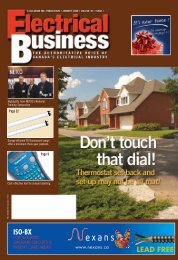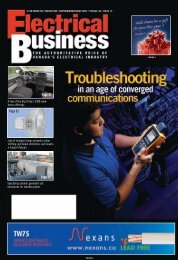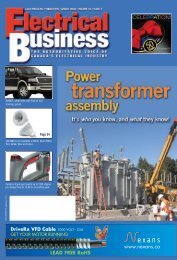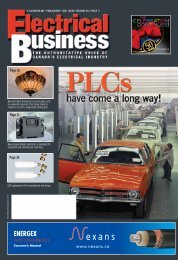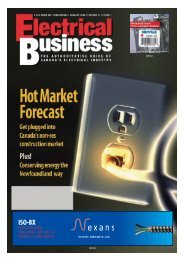Download - Electrical Business Magazine
Download - Electrical Business Magazine
Download - Electrical Business Magazine
You also want an ePaper? Increase the reach of your titles
YUMPU automatically turns print PDFs into web optimized ePapers that Google loves.
CODE FILEBY KRIS PASZKOWIAK, P.ENG.Rigid PVC conduit in residential applicationsRigid PVC (polyvinyl chloride) conduit is a remarkablesolution for a residential consumer supply service,where the PVC is used to protect and route servicesupply conductors. There are many advantages to using PVCconduit installed outdoors, as it can be installed in damp,dry or wet locations. It can be encased in concrete, exposedsurface-mounted or buried directly underground in almostany weather conditions.The material doesn’t oxidize (rust) and resists moistureand corrosive substances. It is lightweight, durable and easyto-assemblebecause joints to fittings are made quickly withslip-on sections. All you need, in essence, is a hacksaw andPVC solvent cement. The conduit is also economical and safe.CEC Rule 12-1100 permits the use of rigid PVC conduitfor exposed or concealed work above- or below-ground inaccordance with the rules for threaded metal conduit.Rule 12-1102, Restrictions on Use states, however, thatrigid PVC must not be enclosed in thermal insulation, whileRule 12-1104, Temperature Limitations, requires it not beused in conditions where the normal temperature exceeds75°C. Conductors having an insulation rating exceeding90°C may be used, provided the ampacity is de-rated to90°C. Rule 12-1106, Mechanical Protection, requires protectionwhere the PVC conduit may be exposed to mechanicalinjury—either during installation or afterward.Rule 12-932, Protection for Raceways in Lanes, requiresprotection for the PVC conduit where subject to mechanicaldamage. It’s not just the LB fitting that requires protection;specifically, steel guards of not less than No. 10 MSG—adequately secured—are required to protect the racewaysystem where installed less than 2 m above grade in lanesand driveways.No matter the material, all conduit and fittings expandand contract with changes in temperature. The expansionand contraction rates are represented by the coefficient ofthermal expansion. Rule 12-1118, Expansion Joints, says thatunless the conduit is grouted in concrete, you should installat least one expansion joint in the run where expansion couldexceed 45 mm.Rigid PVC conduit must not be threaded into a metal hub.The higher coefficient of expansion of the PVC inside the metalhub will result in damage either to the PVC nipple or the hub.Rule 12-1112, Fittings, requires that a female-threaded PVCadapter be used in conjunction with a metal conduit nipple toterminate at a threaded conduit entry in metal enclosures.Time and again, home owners experience a break in therigid PVC conduit at the meter base, or below where the PVCconduit emerges from the concrete slab. The most commonculprit is frost heaving, when soil expands/contracts due tofreezing and thawing. This active process can cause the rigidPVC conduit to be pulled out of the meter base, exposing theservice supply conductors or the load-side conductors.Over time, the rubbing of the conductors against thesharp metal side of the meter base can result in an electricalsafety hazard, which can lead to service interruption or other,more serious, problems. Under certain circumstances, theresulting electrical shortcircuit may cause violentejection of the meter base.What is the best choice formaking a rigid PVC conduitrepair? Some PVC conduitmanufacturers provide PVCconduit repair kits; some areeasy-to-use and do not needspecialized tools, while someothers do. One easy methodof repair is based on the useof standard parts such as theexpansion joint. In some situations, this is a quality solutionthat will allow for movement and, as such, will prevent anyfuture damage (photo). As always, the conduit requires properfastening and support with straps.This simple method saves time and money. It results ina flexible and safe installation that meets the safety coderequirements.Kris Paszkowiak is principal of CodeSafety Associates, a consultingfirm serving the needs of the electrical industry. He holds a MasterElectrician licence and has served numerous organizations over theyears, including the Canadian Advisory Council on <strong>Electrical</strong> Safety,Committee on CEC Part I and UL <strong>Electrical</strong> Council. E-mail CodeSafetyAssociates at kris.paszkowiak@codesafety.ca.Questions and answerscompiled by the <strong>Electrical</strong>Safety AuthorityQuestion 1A splitter with a separate screw or studfor each connection shall be installed, inan accessible location, where two or moreconductors are connected to a conductorlarger than No. 6 AWG copper or No. 4 AWGaluminum.Answers▼▼▼to Code Conundrum<strong>Electrical</strong> <strong>Business</strong> October 2008Q-1: Flexible metal conduit shall be permittedto be installed as a general purpose raceway inor on buildings or portions of buildings of eithercombustible or non-combustible construction.Always consultthe electrical inspectionauthority in your province/territory for more specificinterpretations.ADVERTISER INDEXTackle theCode Conundrum...if you dareSo, you think you know the electrical code, eh?Well, we’ll soon find out if you’re an electrical codejunkie or downright code-clueless. Take a look atthe following questions and check your answers inJanuary’s <strong>Electrical</strong> <strong>Business</strong>.How did you do?3 of 3 – Not only are you smart, you love to show off.2 of 3 – You’re pretty smart, but you still missed one.1 of 3 – Your understanding of these questionsis not up to code.0 of 3 – Did you come up with your answers by playingEenie, Meenie, Minie, Moe?a) Trueb) FalseQuestion 2At least ___ mm of free conductorshall be left at each outlet for makinga joint or fixture connection, unless theconductor is intended to loop throughlamp holders, receptacles or similardevices without joints.a) 50 mm c) 150 mmb) 100 mm d) 200 mmQuestion 3Solid-state devices shall be permittedto be used as isolating switches or asdisconnecting means.a) Trueb) Falsea) True. Rule 12-1002. The rules for flexiblemetal conduit do not place any restrictions on itsuse as a general purpose raceway..Q-2: <strong>Electrical</strong> non-metallic tubing shall besecurely fastened in place within 300 mm of everybox or fitting, and at intervals of not more than 1.5m throughout the run.b) False. Rule 12-1504 Supports tellsus that electrical NM tubing shall be securelyfastened in place within 1 m of each outlet/junction box, cabinet, coupling or fitting,and the spacing between supports shall benot more than 1 m.Q-3: Where electrical equipment is, or is likely tobe, splashed by water, it shall be of a weatherproofor watertight type of construction.a) True. Rule 22-102(4).Advertiser . . . . . . . . . . . . . . . . . . . . . . . . . . . . .PageAeroflo . . . . . . . . . . . . . . . . . . . . . . . . . . . . . . . . . .29Arlington Indistries . . . . . . . . . . . . . . . . . . . . . . . .23Cablofil . . . . . . . . . . . . . . . . . . . . . . . . . . . . . . . . .15Canadian Standards Association . . . . . . . . . 25 & 30Chrysler . . . . . . . . . . . . . . . . . . . . . . . . . . . . . . . . .21Cooper Lighting . . . . . . . . . . . . . . . . . . . . . . . . . . .24Falvo . . . . . . . . . . . . . . . . . . . . . . . . . . . . . . . . . . .29Fluke Electronics . . . . . . . . . . . . . . . . . . . 6, 18 & 29General Electric . . . . . . . . . . . . . . . . . . . . . . 29 & 32Hammond Mfg. Inc. . . . . . . . . . . . . . . . . . . . . . . . .12Hellermann Tyton. . . . . . . . . . . . . . . . . . . . . . . . . . .20Hubbell Canada Inc. . . . . . . . . . . . . . . . . . . . . . . . .4I.E.D. Limited Partnership . . . . . . . . . . . . . . . . . . .13Maxis Tools . . . . . . . . . . . . . . . . . . . . . . . . . . . . . . .17Nexans Canada Inc. . . . . . . . . . . . . . . . . . . . . . . . . .1Northern Cables . . . . . . . . . . . . . . . . . . . . . . . . . . . .7Power Survey . . . . . . . . . . . . . . . . . . . . . . . . . . . . .29Pre-Apprenticeship Training Intst. . . . . . . . . . . . . .27Raylew Power Systems . . . . . . . . . . . . . . . . . . . . . .29Schneider Electric . . . . . . . . . . . . . . . . . . . . 19 & 28Standard Products . . . . . . . . . . . . . . . . . . . . . . . . . .2Thomas & Betts . . . . . . . . . . . . . . . . . . 1, 5, 11 & 29Ultrasave Lighting . . . . . . . . . . . . . . . . . . . . . . . . .10Underground Devices . . . . . . . . . . . . . . . . . . . . . . .26Venture Lighting . . . . . . . . . . . . . . . . . . . . . . . . . . .31Waltech Associates . . . . . . . . . . . . . . . . . . . . . . . .29WEG Motors & Drives / VJ Pamensky . . . . . . . . . . . .9CSA_banner_EB_NovDec08.indd 130 • NOVEMBER/DECEMBER 2008 • www. mag.com11/5/08 11:43:16 AM





